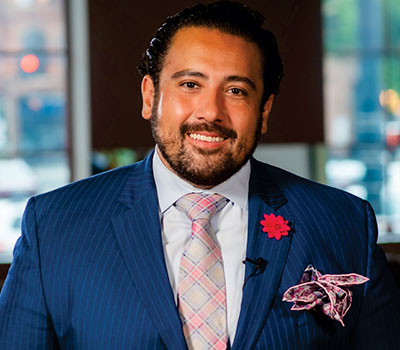Dominick Purnomo grew up in restaurants, working for his parents’ Capital Region stalwart, Yono’s, bussing tables and checking coats in high school before attending school for Hotel and Restaurant Management. In his own words, Purnomo shares how he caught the wine bug in his Personal Taste story for our Winter 2023 issue. Now Purnomo serves as a Director on the board of the New York State Restaurant Association, and runs Dominick Purnomo Restaurant Group (Yono’s, dp An American Brasserie, Day Line, Patrick Henry’s, James Newbury, and The Wire Event Center). As a leader in the hospitality space, he remains passionate about wine. —Caitlin Griffith


What are a few regions that you’re loving right now?
You know, the standard answer is Champagne. Given my druthers, I would drink it every day. We have a heavy focus on the classics at Yono’s, so a lot of Champagne.
Next up, I would lump Austria and Germany — those wines tend to go well with all foods, are great on their own, they’re high-acid and aromatic. Von Winning Sauvignon Blanc has been a complete home run for us. I tasted it at the Skurnik offices back in the summer and, for whatever reason, it just, you know, it just stood out to me. Whenever we taste sauvignon blanc, our mind goes to France and into the Loire, but this wine is just razor-sharp and has beautiful aromatics. Tons of sort of bone-crushing acidity—it just kind of blew me away, that’s a fantastic value. We pour it by the glass and by the bottle.
We try to [find] more obscure places where we can find value . Unfortunately, the classics are expensive, so we’re always looking for [value]. [We pour] the Dizsnókō, a Tokaji that’s a [dry furmint] wine I really enjoy a lot lately—incredible aromatics, super lean, good texture to it, unencumbered with oak. [It] is a square peg, something that certainly doesn’t fit in with what people perceive in their mind of what they think they want to drink. Then they taste it and they love it.
And finally, I’m interested in a lot of the reds coming out of the Finger Lakes these days. For so long, everybody’s perceptions have been off, thinking that Finger Lakes producers only make sweet wine or they only make good riesling. Now they make fantastic syrah. Let’s face it, the world is on fire right now. How many more 17 percent California cabernets can we be drinking? As the climate changes, those cooler-climate places are making some beautifully balanced wines. Those red wines tend to be more food-friendly. They’re lighter in body; there’s more acid. There’s a lot of complexity to them—not just loaded up with tons of fruit and alcohol.
What was the most exciting bottle for you to sell this year?
We sold a bottle of ’89 Pétrus I’ve been sitting on; it’s been in our cellar for probably the better part of two decades. You know, you’re excited to sell it but then you’re sad to see it gone. But this was great: A couple, relatively young, from California, had flown into Albany airport and their luggage got lost. They found us [Yono’s] online, and had dinner. They ordered three different bottles of wine and you know they corked some of them and shared some with the staff, they were just so excited to be there. It’s awesome. Just utter happenstance that their luggage got lost and they found their way to us. They had a great experience and loved it.
Anything new added to your list of classics and New York State wine this past year?
Josh [Turo], our Managing Partner, has gotten into is a lot of cooler-climate wines from New Zealand. So that’s been an area that he was pushing—and, specifically, Smith & Sheth. They’re not inexpensive but nothing is these days, so that was something that we brought in—had a wine dinner with the winemaker—really well received by the guests. Obviously, people are very familiar with New Zealand sauvignon blanc but the pinot noir that comes out of there is spectacular—very cool-climate. The world is shifting. You have a great cool climate growing region. Makes sense? Definitely.
What are some of the changes in the industry that you’ve seen over the past year?
At least in New York, we’re starting to deal with cannabis. People are coming in with a little buzz before they’ve had their first drink—getting the same effect, just doing it differently. Maybe instead of a whole bottle they’re just having a glass of wine. It’s definitely affecting volume.
Instead of people coming in for a cocktail, then wine with dinner, maybe they are just having wine. Again, maybe it’s cannabis use that’s increasing, and maybe this is all in my head. But I think that there’s an impact on the industry. I serve on the board of the New York State Restaurant Association and we have a test committee that I’m sitting on now, just to talk about what does it [cannabis use] look like? If you have a liquor license, you can’t have a cannabis license—for now; that may change—and at some point do restaurants just serve THC-laced drinks and food? And [decide not] to deal with a liquor license? That remains to be seen, and is certainly something that stays on our radar.
I think we’re still crawling back [from COVID-19]. I know that the industry as a whole is still suffering. The younger generations are not in restaurants these days as much as they’re Doordashing—probably 60 percent of meals a week. I think people changed their spending habits, they changed their eating habits, their drinking habits.
Overall, food sales are up. But if you look at where the numbers are up, a lot of it is in takeout and delivery. In New York, alcohol to-go certainly helps for people who want to get their dinner to go and want to bring wine or cocktails with them. We’ve also seen lunch business… the business lunch more or less doesn’t exist in the US anymore. We reopened for lunch for the holiday season, for a couple weeks, to capitalize on the smaller office parties and things like that. Forget the two-Martini lunch, or even the one-Martini lunch or six people putting down a bottle of wine, at least in our neck of the woods! And then, the last part that’s affecting us is dining times. The seven o’clock—eight o’clock on the weekends—that was the sweet spot for a reservation. And now that a lot of people are continuing to work from home, they are coming to dinner at six o’clock—the new hotspot! We’ve seen that pattern of behavior over the last two years, maybe three years—since things slowly started getting back to where they are. But, for restaurants, we can’t survive on one turn. We’ve got to find creative ways to deal with less volume because you need to staff—eight cooks in the kitchen—to get through a dinner service. Whether you’re doing one turn or three, you still need those eight cooks. We’ve had to learn how to pivot and make sure we can still offer guests the full service that they’re expecting.
Caitlin Griffith knew her future career would entail food and drink when, at the age of six, she munched an anchovy from her father’s Caesar salad thinking it as a small strip of bacon—and was more than pleasantly surprised. While enrolled in New York University’s Food Studies program, she learned the secrets of affinage in the caves of Murray’s Cheese.
This is a W&S web exclusive. Get access to all of our feature stories by signing up today.




















